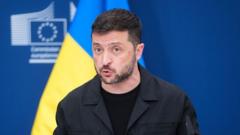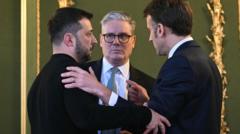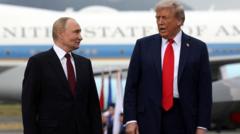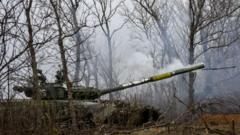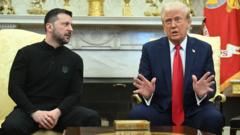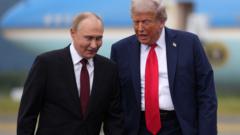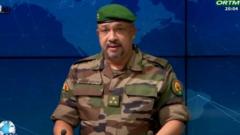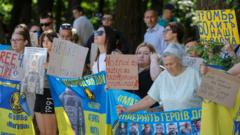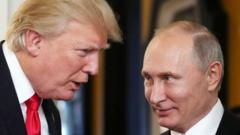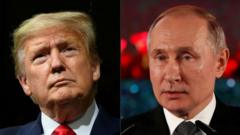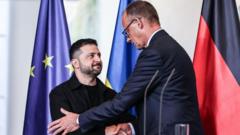The meeting, featuring key figures such as NATO's Secretary General and several European heads of state, is viewed as a crucial moment for diplomatic efforts to secure a peace agreement amidst renewed hostilities in Ukraine.**
Zelensky Rallying Allies for Critical Peace Talks in Washington**
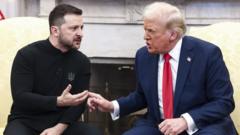
Zelensky Rallying Allies for Critical Peace Talks in Washington**
Ukrainian President Volodymyr Zelensky arrives in Washington with European leaders to discuss strategies aimed at resolving the ongoing conflict with Russia.**
In a historic diplomatic move, Ukrainian President Volodymyr Zelensky is set to meet with U.S. President Donald Trump in Washington on Monday, marking their first encounter since a contentious discussion earlier this year. This time, Zelensky will be joined by influential European leaders, including NATO Secretary General Mark Rutte and UK Prime Minister Sir Keir Starmer, as they strategize on approaches to end the ongoing war with Russia.
The urgency of this gathering has intensified following recent developments, including Trump's summit with Russian President Vladimir Putin, where discussions shifted from ceasefire demands to seeking a comprehensive peace deal. As negotiations evolve, a U.S envoy revealed that Putin showed willingness for a potential NATO-like security pact for Ukraine.
The gravity of the situation is underscored by the unprecedented number of world leaders embarking on an emergency trip to Washington amid a wartime crisis. Diplomatic insiders express concern about potential pressure on Zelensky to compromise, especially after the Ukrainian leader was notably absent from the Trump-Putin meeting last week. However, U.S. Secretary of State Marco Rubio dismissed the notion that Zelensky could be coerced by Trump into a peace agreement, labeling it an oversimplified media narrative.
The mood surrounding NATO leaders appears tense, with prior engagements between Zelensky and Trump marked by discord. A previous meeting resulted in a dramatic confrontation in the Oval Office, prompting European leaders to work diligently to restore trust between Kyiv and Washington. Zelensky has reportedly been briefed to adopt a deal-making rhetoric in discussions, a strategy aimed at resonating with Trump.
Recent interactions have seen progress, with Ukraine securing agreements that ensure U.S. investment in local resources, and a subsequent positive phone conversation between the two leaders has been noted. However, the realities on the battlefield remain dire, with Russian forces advancing and now controlling nearly one-fifth of Ukraine since their full-scale invasion in February 2022.
On the eve of this critical meeting, Zelensky participated in a virtual summit with European allies, reaffirming a united front and outlining their objectives for the talks with Trump. Reports emerged about potential "robust security guarantees" that could significantly alter the security dynamics for Ukraine, hinting at Article 5 protections akin to those provided by NATO.
The ongoing conflict, particularly concerning contested regions like Donetsk and Luhansk, remains contentious. Zelensky has emphasized that discussions of territorial concessions must occur through a trilateral summit involving U.S. participation—a stance that adheres to Ukraine's constitutional mandate against land forfeiture. While optimism lingers among some, Secretary Rubio tempered expectations, indicating substantial hurdles remain in achieving a lasting resolution to this devastating conflict.
The urgency of this gathering has intensified following recent developments, including Trump's summit with Russian President Vladimir Putin, where discussions shifted from ceasefire demands to seeking a comprehensive peace deal. As negotiations evolve, a U.S envoy revealed that Putin showed willingness for a potential NATO-like security pact for Ukraine.
The gravity of the situation is underscored by the unprecedented number of world leaders embarking on an emergency trip to Washington amid a wartime crisis. Diplomatic insiders express concern about potential pressure on Zelensky to compromise, especially after the Ukrainian leader was notably absent from the Trump-Putin meeting last week. However, U.S. Secretary of State Marco Rubio dismissed the notion that Zelensky could be coerced by Trump into a peace agreement, labeling it an oversimplified media narrative.
The mood surrounding NATO leaders appears tense, with prior engagements between Zelensky and Trump marked by discord. A previous meeting resulted in a dramatic confrontation in the Oval Office, prompting European leaders to work diligently to restore trust between Kyiv and Washington. Zelensky has reportedly been briefed to adopt a deal-making rhetoric in discussions, a strategy aimed at resonating with Trump.
Recent interactions have seen progress, with Ukraine securing agreements that ensure U.S. investment in local resources, and a subsequent positive phone conversation between the two leaders has been noted. However, the realities on the battlefield remain dire, with Russian forces advancing and now controlling nearly one-fifth of Ukraine since their full-scale invasion in February 2022.
On the eve of this critical meeting, Zelensky participated in a virtual summit with European allies, reaffirming a united front and outlining their objectives for the talks with Trump. Reports emerged about potential "robust security guarantees" that could significantly alter the security dynamics for Ukraine, hinting at Article 5 protections akin to those provided by NATO.
The ongoing conflict, particularly concerning contested regions like Donetsk and Luhansk, remains contentious. Zelensky has emphasized that discussions of territorial concessions must occur through a trilateral summit involving U.S. participation—a stance that adheres to Ukraine's constitutional mandate against land forfeiture. While optimism lingers among some, Secretary Rubio tempered expectations, indicating substantial hurdles remain in achieving a lasting resolution to this devastating conflict.


